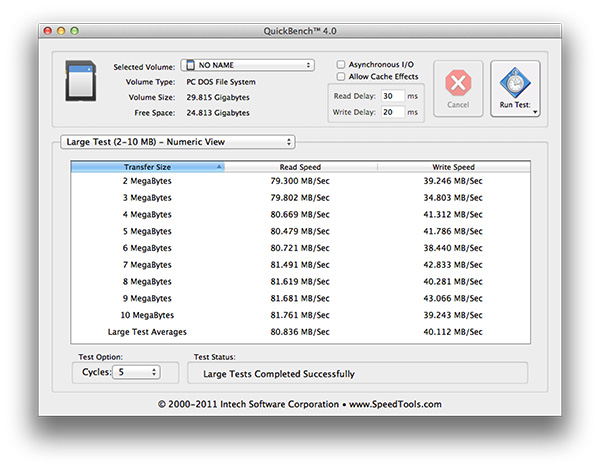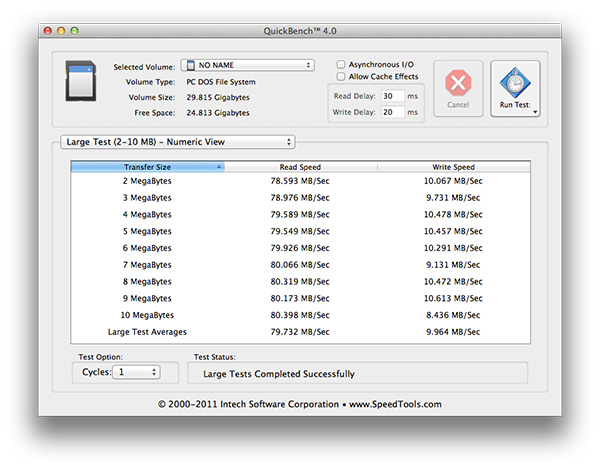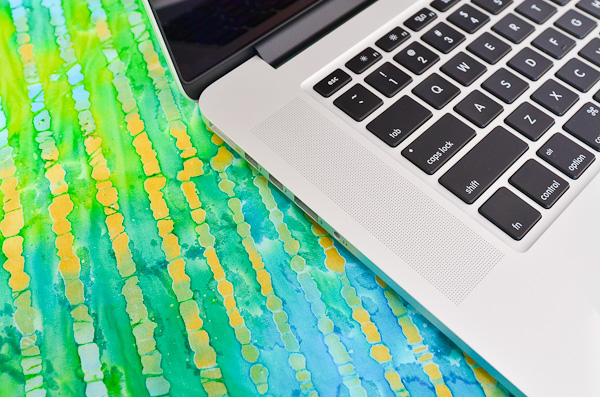The next-gen MacBook Pro with Retina Display Review
by Anand Lal Shimpi on June 23, 2012 4:14 AM EST- Posted in
- Mac
- Apple
- MacBook Pro
- Laptops
- Notebooks
WiFi Performance
The next-gen MacBook Pro is equipped with a decidedly this-gen wireless stack. In other words it uses the same 3x3:3 WiFi solution that was present in the 2011 MacBook Pro and is present in the non-Retina 2012 MacBook Pro as well: Broadcom’s BCM4331. The wireless behavior characteristics are a bit different since this is a physically different chassis, but we’re still dealing with a 3-stream 802.11n solution - not 802.11ac. All three antennas are located in the Retina Display’s housing.
We have seen Apple be conservative with component choices in the past. Deciding to stick with Samsung’s 45nm LP process for the A5X instead of embracing 32nm LP sooner with the 3rd gen iPad is one example that comes to mind. Like a good silicon company Apple appears to mitigate risk in design by sticking with known-good components wherever possible. Major changes to the industrial design are typically paired with comparatively minor silicon changes, and other components are kept as static as possible so long as they don’t overly compromise experience. While 802.11ac dongles and routers are just arriving today, Apple likely froze the Retina MBP’s wireless configuration quite a while ago. Rather than be caught shipping potentially unratified hardware, Apple went the safe route and stuck with 802.11n.

That’s not to say Apple’s wireless implementation is bad. The 15-inch MacBook Pro has been one of the best behaved notebooks on wireless that I’ve had the pleasure of using. The MacBook Pro with Retina Display is no different. Just like before, the best case negotiated physical rate is 450Mbps when paired with a 5GHz 3x3 access point. Unobstructed, within a couple of feet of the AP, I measured as much as 230Mbps to the Retina MacBook Pro. I tested at three different distances from the AP, through walls and on both 2.4GHz and 5GHz bands. Overall performance seemed comparable to the standard 15-inch MacBook Pro, although it’s definitely faster in some areas and slower in others.
| Location 1 | Location 2 | Location 3 | |
| 2011 MacBook Pro (2.4GHz) | 124.0 Mbps | 12.6 Mbps | 61.6 Mbps |
| Retina MacBook Pro (2.4GHz) | 117.9 Mbps | 87.6 Mbps | 44.0 Mbps |
| 2011 MacBook Pro (5GHz) | 186.8 Mbps | 154.6 Mbps | 24.7 Mbps |
| Retina MacBook Pro (5GHz) | 227.7 Mbps | 156.8 Mbps | 33.7 Mbps |
The second test location consistently performed poorly on the 2011 MBP, only on 2.4GHz however. For the most part there were no real surprises otherwise.
The SD Card Reader
It was our own Brian Klug who clued me into the horrible behavior of the 2011 MacBook Pro’s SD card reader. Depending on the SD card used, the integrated SD card reader either performed admirably or was the most frustrating part of the Mac experience. Out of the three SD cards I frequently use: a Patriot LX series card, a Transcend and a new UHS-I Patriot EP Pro, only the Transcend card actually works remotely well with the 2011 chassis. Even then, it’s not perfect. I usually have to insert and remove the card at least once before the reader will recognize it. The LX and EP Pro on the other hand are measurably worse. To get the EP Pro to work in the 2011 MBP’s reader I usually have to push the card in then apply upward or downward force to the exposed edge of the card to get it to read properly. Even then it’ll usually disappear from OS X or be present but read at bytes per second. I doubt this is the fault of the card itself but rather the latest example of incompatibility with the horrible SD card reader in last year’s MacBook Pro.
At least with the cards I’ve tested, the Retina MacBook Pro exhibits none of these issues. Over dozens of insertions I had no issues reading from or writing to all three of these cards, including the problematic ones. I ran a Quick Bench test on the EP Pro as it’s the fastest of the lot and came away with reasonable performance as well. Roughly 80MB/s reads and 40MB/s writes. The numbers are shy of Patriot’s 90/50 spec but quite good.
One of the times I was able to get the EP Pro working in the 2011 MacBook Pro I managed to squeeze in a single Quick Bench run. Read performance was almost identical at 80MB/s, but write performance was far lower at only 10MB/s:
Shortly after the test completed I could no longer write to the drive in the 2011 MBP so I suspect the card reader was acting up again. Needless to say, if you like using SD cards with your MacBook Pro the Retina Display model appears to be much better. That’s not to say there couldn’t be other incompatibilities, but in everything I tested it looks like this problem is finally fixed.
Better Speakers and Dual Mics
Apple is proud of its new speaker design in the Retina MacBook Pro. There’s not a whole lot you can do for tiny laptop speakers but despite shrinking the overall volume of the chassis, Apple has managed to deliver much better sound out of the new speakers in the rMBP. Like most of the upgrades to the next-gen MacBook Pro, you really need to do an A/B comparison to appreciate the difference. And keep your expectations in line with reality, a good set of external speakers are always going to sound better. With that said, the new speakers definitely deliver a fuller, more rich sound than their predecessor. You can still tell you’re listening to some form of integrated speakers, but now they sound distinctly less like they’re coming from a inside a notebook.
In preparation for Mountain Lion's arrival with dictation support, Apple outfitted the next-gen MacBook Pro with dual microphones in order to better focus on your spoken voice and not on background noise. In practice the new mics work reasonably well, rejecting moderate volume background noise. Loud music nearby will still cause interference and as always, accurate dictation requires more than just good quality source audio to get right.













471 Comments
View All Comments
Sabresiberian - Tuesday, June 26, 2012 - link
Haven't been interested in anything Apple since the Lisa, but I'm actually tempted to get one of these - which is saying a lot because I'm not a fan of the company at all.One thing for sure; I'm sure not interested in buying a different laptop made by someone else with a lousy display! You want my business, I suggest you at least follow Apple's lead here.
I couldn't agree with Anand more on the state of quality of monitors in general - and the fact that you can buy a (Korean) 2560x1440 monitor now for $300, including shipping from S. Korea, tells the story on affordability there.
;)
orthorim - Wednesday, June 27, 2012 - link
Compared to this review, all the others out there are more or less a variation of "ohhhh... shiny!".Thanks for this fantastic in-depth article, AnandTech!
darwiniandude - Friday, June 29, 2012 - link
Still waiting for mine to arrive, although I've used the rMBP a fair bit in the mean time.Not sure why 1/3rd of the comments are about a Sony Z series, and couldn't see mention of real word battery life tests?
Regardless, 1st gen rMBP is an awesome product, and just like with the 1st MacBook Air, this model will look terrible compared to its 2nd or 3rd gen. Can't wait.
danrhiggins - Saturday, June 30, 2012 - link
I have been trying to talk myself into buying the MBR for two weeks now to replace my 2011 17" MBP (to which I added SSD) because the 17" is just a bit too large/heavy to carry around. I use the 17" mostly for my photography hobby.The problem is that my main computer is a 13" Macbook air and I jumped on the new 2012 MBA - which I love. So after reading your article I took my 2012 MBA down to the Apple store and put it alongside the MBR on display. Then I brought up ESPN.com and created a couple of matching "virtual" desktops all in full screen mode. (I used MS Excel and one of the included templates for one of the windows as that would be mostly the same on both machines.)
Then I scrolled up and down and swiped from left to right on both machines at the same time. I wanted to see if any of the issues described here manifested themselves in this admittedly crude comparison. I tried different resolutions on the MBR. (I would not be interested in the "Best for Retina" as I would be looking for more screen real estate.) I also tried it with graphics switching turned on and off.
Where scrolling on the MBA was very smooth, be it up/down scrolling in Safari or in Excel or side to side scrolling between desktops, the MBR was noticeably jittery in comparison. It reminded me of when my HD cable signal has a bit of interference and can't quite keep up.
To those coming from older MBP's this may not be an issue. But having grown accustomed to the much smoother operation (IMHO) of the MBA the MBA wins. For now. Yes, they are different machines with different goals. But I don't need the extra I/O ports (1 Thunderbolt and 2 USB 3 is enough given that I use BT keyboard and trackpad) and a Thunderbolt display as a "docking station".
I look forward to the day that the MBR will have the smooth graphics of the MBA and have addressed any other issues. Then I will get one to replace my 17" MBP. Maybe Mountain Lion and a firmware upgrade or two will clean this up. Or maybe not until the next generation or two. Then the hardware and the software (including 3rd party) will catch up.
Thanks again for your review. I was going to buy one today. They had what I needed at the Apple Store. But because of your review I did this test and I'm glad I did. Now I'll wait. And there will be one more available for all of those anxious to upgrade.
marraco - Sunday, July 1, 2012 - link
The retina display is a waste with that crappy Intel video.Fingalterre - Sunday, July 1, 2012 - link
I have the Z from 2010. It is still as faster or as fast with its graphics and i620 processor as the latest Air or 13" Pro to which it is directly comparable. What the Z lacks is the multitouch ability and the scalability of the Air or Retina Pro. What I am left with is a computer whose graphics are too small to read and a mousepad too small to scroll with easily. Also, after using Windows and Lion, I think Windows 7 is just not as user friendly as OS X. The form factor of the Air and Retina Pro are also a joy when you travel, which I do much. The Mac App store, though limited compared to the IOS, also is something Sony just doesn't have.I have been a Windows user for 20 years after Apple lost me with their limited selection and miscues. I still have my reservations about their corporate culture, but right now, they are producing superior products, a well thought out support network, and works of beauty of art, which distinguish them from all other OEMs. Dell once did this--my wife kept her Dell 5150 laptop for 7 years, only to trade it in for a 17 in XPS which didn't work and which was not well supported,, and then to a Mac Book Air in 2010, which has met her every need (as a high end IT security person). My Retina Pro arrives on July 20 and my Z is going to Ebay to pay for it.
negativeions - Monday, July 2, 2012 - link
What is the point in retina? Who cares. I mean it's ok, but the scaling is so utterly stupid it's beyond belief. Why in God's name don't Apple just program proper resolution independence into OSX... Then you could have any bloody user space you want with any resolution.Steelbom - Monday, July 2, 2012 - link
What's the point? It looks fantastic. And why is the scaling stupid? It's a pretty great way to handle it.gunny2k6 - Tuesday, July 3, 2012 - link
http://www.eurocom.com/products/index.htmcheck the EUROCOM Panther 3.0
talk about apple making high end partts in laptops i call BS ... this compnay and many others like Clevo and Lenovo before they bourght IBM's pc hardware side ... have been putting high end things in laptops since the BLOODY Pentium 4 Northwood !!!!
http://www.clevo.com.tw/en/index.asp
http://www.pcspecialist.co.uk/notebooks/vortexIII-...
THEY ALL BEEN DOING IT FOR YEARS!!!!!!!!!!!!!!!!!!!!!!!!!!!!!!!!!!!!!!!!!!!!!! before apple moved to intel !
yes not for everyone as there big heavy and expensive what jobs did was bring those peoples ides to the masses !! when they moved to Intel .... they kept the high price tag from the PowerPC to the cheaper to make Intel based system and then used that spare cash for R&D to make the above ideas work for the masses !!
gunny2k6 - Tuesday, July 3, 2012 - link
for got to say let me guess a years time we will see apple do something like this and all the praise will go to Apple for "inventing it "